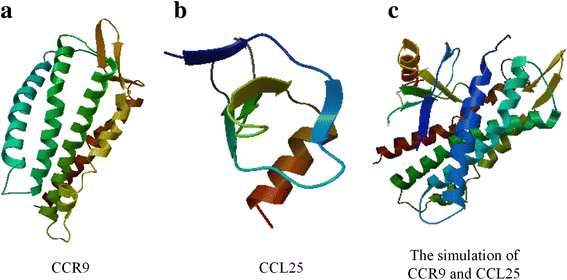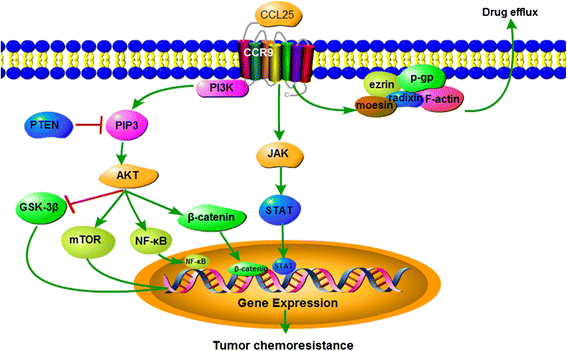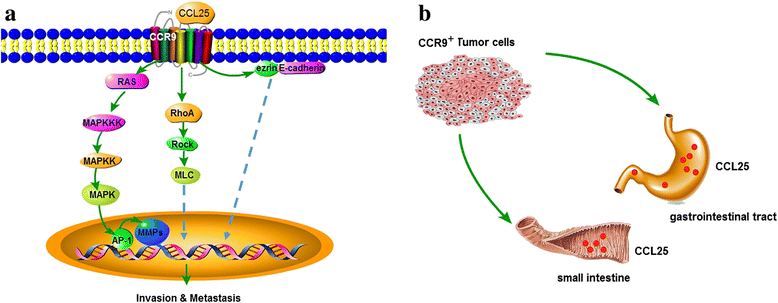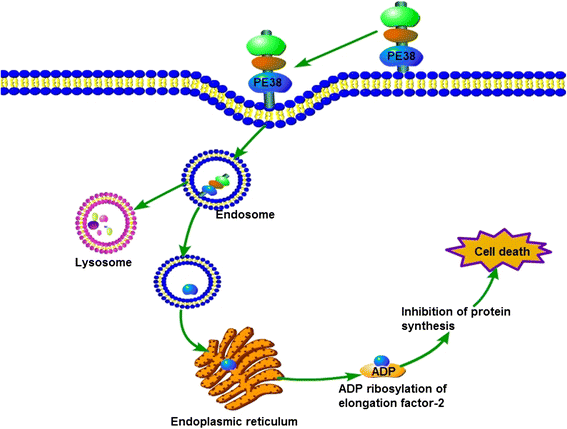CCR9 in cancer: oncogenic role and therapeutic targeting
- PMID: 26879872
- PMCID: PMC4754913
- DOI: 10.1186/s13045-016-0236-7
CCR9 in cancer: oncogenic role and therapeutic targeting
Abstract
Cancer is currently one of the leading causes of death worldwide and is one of the most challenging major public health problems. The main challenges faced by clinicians in the management and treatment of cancer mainly arise from difficulties in early diagnosis and the emergence of tumor chemoresistance and metastasis. The structures of chemokine receptor 9 (CCR9) and its specific ligand chemokine ligand 25 (CCL25) have been elucidated, and, interestingly, a number of studies have demonstrated that CCR9 is a potential tumor biomarker in diagnosis and therapy, as it has been found to be highly expressed in a wide range of cancers. This expression pattern suggests that CCR9 may participate in many important biological activities involved in cancer progression. Researchers have shown that CCR9 that has been activated by its specific ligand CCL25 can interact with many signaling pathways, especially those involved in tumor chemoresistance and metastasis. This review, therefore, focuses on CCR9 induction activity and summarizes what is currently known regarding its role in cancers and its potential application in tumor-targeted therapy.
Figures





Similar articles
-
CCR9 mediates PI3K/AKT-dependent antiapoptotic signals in prostate cancer cells and inhibition of CCR9-CCL25 interaction enhances the cytotoxic effects of etoposide.Int J Cancer. 2010 Nov 1;127(9):2020-30. doi: 10.1002/ijc.25219. Int J Cancer. 2010. PMID: 20127861
-
CCR9 and CCL25: A review of their roles in tumor promotion.J Cell Physiol. 2020 Dec;235(12):9121-9132. doi: 10.1002/jcp.29782. Epub 2020 May 13. J Cell Physiol. 2020. PMID: 32401349 Review.
-
CCR9-mediated signaling through β-catenin and identification of a novel CCR9 antagonist.Mol Oncol. 2015 Oct;9(8):1599-611. doi: 10.1016/j.molonc.2015.04.012. Epub 2015 May 12. Mol Oncol. 2015. PMID: 26003048 Free PMC article.
-
CCL25/CCR9 Signal Promotes Migration and Invasion in Hepatocellular and Breast Cancer Cell Lines.DNA Cell Biol. 2016 Jul;35(7):348-57. doi: 10.1089/dna.2015.3104. Epub 2016 Mar 23. DNA Cell Biol. 2016. PMID: 27008282
-
CC Chemokines in a Tumor: A Review of Pro-Cancer and Anti-Cancer Properties of Receptors CCR5, CCR6, CCR7, CCR8, CCR9, and CCR10 Ligands.Int J Mol Sci. 2020 Oct 15;21(20):7619. doi: 10.3390/ijms21207619. Int J Mol Sci. 2020. PMID: 33076281 Free PMC article. Review.
Cited by
-
Investigating novel biomarkers in uterine corpus endometrial carcinoma: in silico analysis and clinical specimens validation via RT-qPCR and immunohistochemistry.Am J Cancer Res. 2023 Sep 15;13(9):4376-4400. eCollection 2023. Am J Cancer Res. 2023. PMID: 37818076 Free PMC article.
-
The Use of Biologics for Targeting GPCRs in Metastatic Cancers.BioTech (Basel). 2025 Jan 30;14(1):7. doi: 10.3390/biotech14010007. BioTech (Basel). 2025. PMID: 39982274 Free PMC article. Review.
-
Signal termination of the chemokine receptor CCR9 is governed by an arrestin-independent phosphorylation mechanism.J Biol Chem. 2025 May;301(5):108462. doi: 10.1016/j.jbc.2025.108462. Epub 2025 Mar 26. J Biol Chem. 2025. PMID: 40154615 Free PMC article.
-
The role of chemokines and interleukins in acute lymphoblastic leukemia: a systematic review.J Appl Biomed. 2024 Dec;22(4):165-184. doi: 10.32725/jab.2024.024. Epub 2024 Dec 4. J Appl Biomed. 2024. PMID: 40033805
-
CCL25/CCR9 interaction promotes the malignant behavior of salivary adenoid cystic carcinoma via the PI3K/AKT signaling pathway.PeerJ. 2022 Aug 19;10:e13844. doi: 10.7717/peerj.13844. eCollection 2022. PeerJ. 2022. PMID: 36003306 Free PMC article.
References
Publication types
MeSH terms
Substances
LinkOut - more resources
Full Text Sources
Other Literature Sources
Molecular Biology Databases

